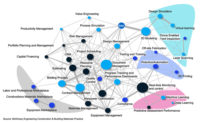Amtrak now plans to replace the tunnel structures by mid-2015, but the Long Island Rail Road trains, which ESA eventually will connect to Grand Central Terminal, uses those tunnels and the interlocking yard in Queens where the trains terminate. The extent of the delay is still being determined.
The SAS, Fulton Street Transit Center and the No. 7 line subway extension, which make up the balance of the capital program, are holding steady so far on the recalibrated budgets and time frames Horodniceanu established when he took the reins in 2008.
He did so at the behest of Elliot Sander, then the chief executive officer of the MTA, who “nonchalantly ofered me this job over breakfast,” recalls Horodniceanu. “I talked Michael into it,” says Sander, now president and chief executive officer of Haks Engineers and Architects, New York City. “I felt he was equipped to face the most extreme technical, political and institutional challenges of a $17-billion program. I thought he would bring an extraordinary background both in the private and public sector.”
Horodniceanu served as city traffic commissioner from 1986 to 1990, then returned to help grow Urbitran Group. During his 18 years with the firm, its profit went from $5 million a year to $36 million annually by the time he left in 2008, the year AECOM bought it.
Although Horodniceanu understands the contrast between New York City's political and engineering cultures, he still faced a daunting role in heading up MTACC. “It took him a while to get his feet wet,” says Barry Schneider, co-chair of Manhattan Community Board 8's Second Avenue Subway Task Force, which represents the neighborhoods affected by the SAS. “I don't think he realized the Second Avenue Subway is really several jobs” in terms of working with very different neighborhoods along the line.
But Schneider praises the MTACC chief for listening to suggestions. “He did a fairly good job of communicating to the property owners and residents what was going on. And now he has announced that he will be holding [quarterly] town-hall meetings. I think that will go a long way to putting a face on SAS and having a dialogue with the community. He is very personable, with the capacity to put people at ease. He has to do more of that. He has all the tools. He gets it. That is the key now for the stakeholders,” Schneider says.
Paul Scagnelli, executive vice president with Schiavone Construction Co., Secaucus, N.J., noted that Horodniceanu has long had a reputation for diplomacy and openness. “He tries to be a fair arbiter of issues,” Scagnelli says. “Many times in these complicated projects, different sides take conflicting positions. Michael is able to listen to both sides and try to construct a resolution. He's open-minded but not a pushover. He makes you perform what you say you can do, but he tries to look at it from both sides. In a large agency with very channeled thinking, that's often hard to do.”
Even MTA's harshest critics offer some praise for Horodniceanu. Gene Russianoff, president of the New York Public Interest Group Straphangers Campaign, a citizen advocacy group, toured the projects. “To me, his biggest accomplishments are moving these behemoths of engineering forward. The MTA and Michael have worked hard at mitigating phase one of the Second Avenue Subway on surrounding areas. Despite genuine efforts, the project remains very disruptive.”
“I think he specifically has done what he can at his level,” says a blogger who follows the SAS closely and asked not to be identified. “It's too big a job—there are so many issues. He has come to at least one board meeting, though he usually sends a deputy. He's made a pretty good effort to go up and down the street.”
In September, a tunnel-boring machine named Adi, after Horodniceanu's granddaughter, broke through to the 63rd Street station, marking a milestone on the project and receiving praise even from critics.













Post a comment to this article
Report Abusive Comment